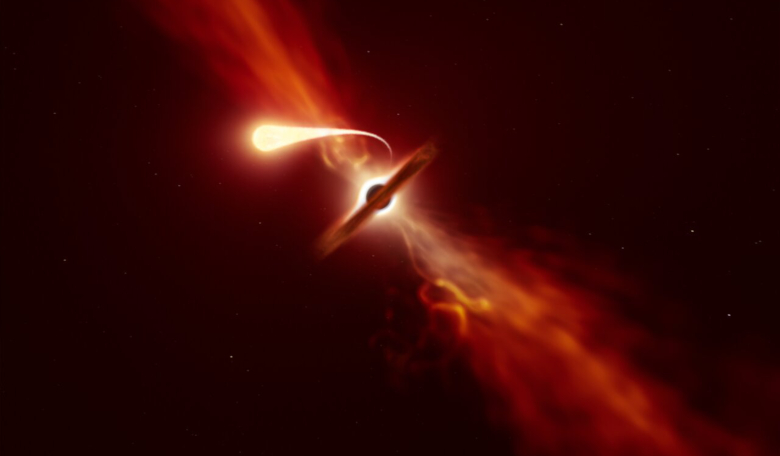Death by spaghettification might sound like you’ve gone to your grave after eating too much pasta, but the term is used in astronomy to describe how an unfortunate star appears when it wanders too close to the enormous gravitational pull of a monstrous black hole and is torn apart. These events are not often caught occurring in real time, but thanks to a coordinated effort by researchers across the globe, a rare blast of light from a star being ripped apart by a supermassive black hole has been caught in unprecedented detail.
Black holes, by their very definition, are extremely difficult to detect. But every now and then, these cavernous pits of doom can be spotted by a tell tale flash of light, caused when they swallow up a star that has strayed too close.
The destruction of a star in this way is referred to as a tidal disruption event (TDE) and it occurs when thin streams of material from the shredded star – the spaghettification part – falls back into the black hole causing a bright flare of energy to be released.
Normally, this release of energy causes some of the shredded stellar material to be propelled outwards enshrouding the event in a blanket of dust and debris.
This stellar debris-screen makes it very hard for astronomers to peer through and see what is happening, but last year a TDE happened close to a supermassive black hole 215 million light years from Earth and an international team of astronomers were fortunate enough to detect the event just a short time after the star was ripped apart.
“Because we caught it early, we could actually see the curtain of dust and debris being drawn up as the black hole launched a powerful outflow of material with velocities up to 10 000 km/s,” says Kate Alexander, NASA Einstein Fellow at Northwestern University in the US and a co-author on this latest research. “This unique ‘peek behind the curtain' provided the first opportunity to pinpoint the origin of the obscuring material and follow in real time how it engulfs the black hole.”
Located in a spiral galaxy in the constellation of Eridanus, the event, dubbed AT2019qiz, is the closest such flare recorded to date.
AT2019qiz was initially detected using telescopes from the European Southern Observatory (ESO) but due to the swift action of the astronomers it meant other instruments that collect data in different wavelengths, including X-shooter and EFOSC2, could also target the flare as it grew in luminosity and then faded away.
“Several sky surveys discovered emission from the new tidal disruption event very quickly after the star was ripped apart,” says study author Thomas Wevers, an ESO Fellow in Santiago, Chile, who was at the Institute of Astronomy, University of Cambridge, UK, when he conducted the work. “We immediately pointed a suite of ground-based and space telescopes in that direction to see how the light was produced.
After six months of extensive observations in ultraviolet, optical, X-ray and radio light, the team could reveal for the first time, a direct connection between the material flowing out from the star and the bright flare emitted as it is devoured by the black hole.
“The observations showed that the star had roughly the same mass as our own Sun, and that it lost about half of that to the monster black hole, which is over a million times more massive,” says says Matt Nicholl, a lecturer and Royal Astronomical Society research fellow at the University of Birmingham, UK, and the lead author of the new study.
The detailed nature of the study could mean that the event acts as a ‘Rosetta stone’ for interpreting future observations of tidal disruption events, say the team. At the very least, it will help better understand supermassive black holes and how matter behaves in the extreme gravity environments around them.
More light could soon be shed on these relatively rare events when ESO’s Extremely Large Telescope (ELT) starts operating this decade.
Nicknamed “the world’s biggest eye on the sky”, this revolutionary new ground-based telescope concept will have a 39-metre main mirror and will be the largest optical/near-infrared telescope in the world.
Designed to conduct detailed studies on subjects including planets around other stars, the first objects in the Universe, the nature and distribution of dark matter and dark energy, it will also enable researchers to solve further mysteries surrounding supermassive black holes by detecting increasingly fainter and faster evolving tidal disruption events.











